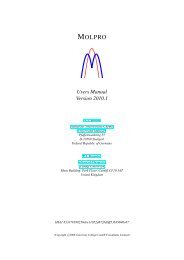Carbon−Carbon Coupling Reactions Catalyzed by Heterogeneous ...
Carbon−Carbon Coupling Reactions Catalyzed by Heterogeneous ...
Carbon−Carbon Coupling Reactions Catalyzed by Heterogeneous ...
Create successful ePaper yourself
Turn your PDF publications into a flip-book with our unique Google optimized e-Paper software.
<strong>Heterogeneous</strong> Pd <strong>Catalyzed</strong> C−C <strong>Coupling</strong> <strong>Reactions</strong> Chemical Reviews, 2007, Vol. 107, No. 1 163<br />
Table 69. Pd/C-<strong>Catalyzed</strong> Ullmann-Type <strong>Coupling</strong> of Aryl<br />
Halides in the Presence of CO2 210<br />
entry Ar-X t a (h) yield b (%)<br />
1 c Ph-I 15 27<br />
2 d Ph-I 15 41<br />
3 Ph-I 8 > 99<br />
4 e Ph-I 8 65<br />
5 4-Me-Ph-I 15 95<br />
6 2-Me-Ph-I 24 87<br />
7 4-MeO-Ph-I 15 97<br />
8 4-CF3-Ph-I 48 95<br />
9 1-Naph-I 24 100<br />
10 Ph-Br 15 91<br />
11 4-MeO-Ph-Br 24 95<br />
12 4-Me2N-Ph-Br 48 85<br />
13 2,6-di-MeO-Ph-Br 72 78<br />
14 f 2-OH-1-Naph-Br 48 81<br />
15 Ph-Cl 36 56<br />
16 g Ph-Cl 36 96<br />
17 g 3,5-di-MeO-Ph-Cl 48 81<br />
18 g 1-Naph-Cl 36 95<br />
19 g 3-EtO2C-Ph-Cl 96 93<br />
a Reaction conditions: ArX (2 mmol); 5% w/w Pd/C (300 mg); Zn<br />
(170 mg); H2O (5 mL); CO2 (1.0 MPa). b Isolated yields. c In the<br />
absence of CO2. d CO2, 1 atm, bubbling. e CO2, 6.0 MPa. f 2-Naphthol<br />
was obtained in 17% yield. g 5% Pd/C (400 mg).<br />
Table 70. Ullmann-Type <strong>Coupling</strong> <strong>Reactions</strong> of Aryl Halides<br />
with Pd/C and In<br />
biaryl<br />
product 174 t (h) yielda (%)<br />
(1-Naph)2 2.5 87<br />
(4-n-Bu-Ph)2 2.5 85<br />
(4-MeO-Ph)2 2.5 91<br />
(3-MeO-Ph)2 2.5 86<br />
(4-HO-Ph)2 2.5 87<br />
(4-EtO2C-Ph)2 2 88<br />
(3-EtO2C-Ph)2 2.5 86<br />
(4-F3C-Ph)2 2 92<br />
(2-F3C-Ph)2 2.5 85<br />
(4-CHO-Ph)2 3 87<br />
(4-Ac-Ph)2 2.5 88<br />
(4-Cl-Ph)2 2 91<br />
(2-thienyl)2 1.5 92<br />
(2-Py)2 1.5 86<br />
(3-Py)2 3 89<br />
a Isolated yield.<br />
Scheme 50. Pd/C-<strong>Catalyzed</strong> Homocoupling of Aryl Iodide<br />
175 in the Presence of Et3N<br />
dehydrogenative homocoupling of pyridines. This is the<br />
simplest and most efficient method. In the early 1960s, Pd/C<br />
was extensively applied as a catalyst to synthesize bipyridine<br />
<strong>by</strong> oxidative coupling of pyridine in the absence of base or<br />
additives. 218-220 In 1971, a series of 2,2′-bipyridines 187 and<br />
2,2′:6′,2′′-terpyridines 188 were prepared <strong>by</strong> refluxing alkylpyridines<br />
186 in the presence of 5% Pd/C catalyst (Table<br />
74). 221<br />
Table 71. Synthesis of Butadienes <strong>by</strong> Pd/C-<strong>Catalyzed</strong> <strong>Coupling</strong><br />
of Vinyl Halides<br />
entry R 1 R 2 yield a (%)<br />
1 n-Hex H 92<br />
2 Ph H 93<br />
3 Ph H 89<br />
4 4-MeO-Ph H 87<br />
5 3-NH2-Ph H 79<br />
6 3-HO-Ph H 72<br />
7 2-Cl-Ph H 89<br />
8 4-F3C-Ph H 88<br />
9 4-Br-Ph H 88<br />
10 4-Py H 89<br />
11 H Ph 91<br />
a Isolated yield.<br />
Table 72. Intramolecular Vinyl and Aryl <strong>Coupling</strong> <strong>Reactions</strong> a<br />
a Reaction performed in the presence of 2.5 mol % of Pd/C, 50 mol<br />
% In and 1.5 equiv of LiCl in DMF (0.5 M) at 100 °C. b Isolated yield.<br />
c 0.05 M LiCl in DMF was used.<br />
Table 73. Pd/C-<strong>Catalyzed</strong> Suzuki-Type Homocoupling of<br />
Arylboronic Acids<br />
a Isolated yield.<br />
In recent years, the Pd/C-catalyzed dehydrogenative<br />
coupling of pyridines was widely applied to the synthesis












![Hetero [6+3] Cycloaddition of Fulvenes with N-Alkylidene Glycine ...](https://img.yumpu.com/35423358/1/190x245/hetero-6-3-cycloaddition-of-fulvenes-with-n-alkylidene-glycine-.jpg?quality=85)




